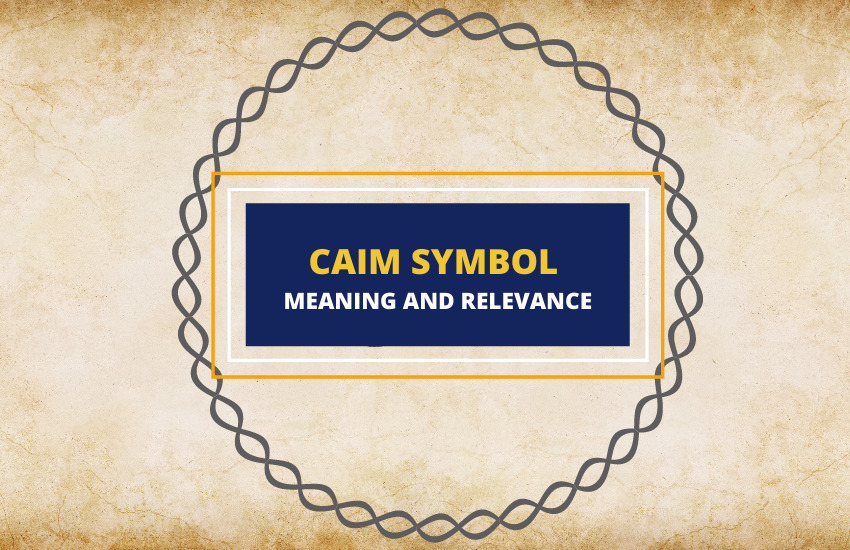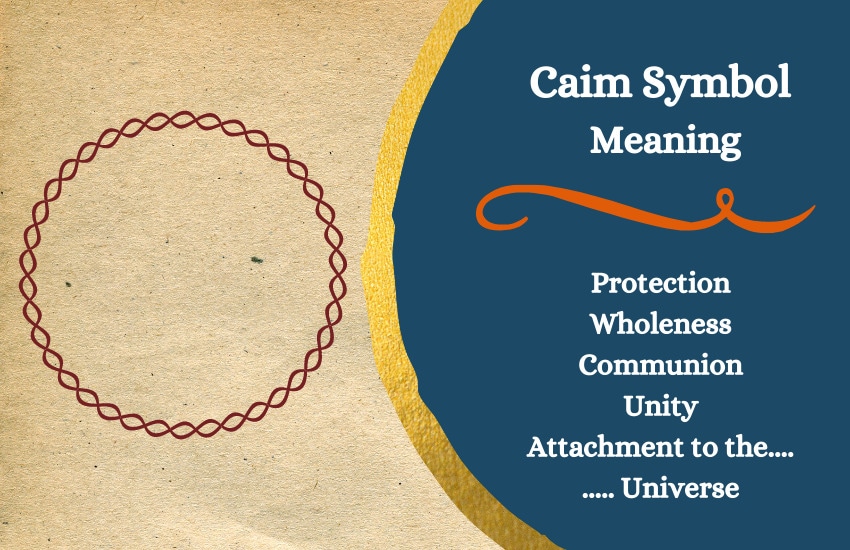
Table of Contents
Celtic culture is home to fascinating practices and symbols. One of the most prominent of these is the Caim symbol, initially cast at altars during wedding ceremonies. More interesting than the symbol itself are the reasons as to why the circle was cast. While the main reason was to create a sanctuary, for some, the circle dealt with their insecurities, as we shall see below.
Meaning Of the Caim Symbol
The Caim is one of the prominent symbols of Celtic culture and stands for protection and/or sanctuary. The term “Caim” in its Gaelic sense means both “circle” and “to bend,” which is evident from the representation of the symbol, which looks like two circles woven together. From its definition and its original use, the Caim, also known as the Celtic Circle, is representative of a protection circle that is accompanied by the chanting of prayer with specific rhyme and style.
What Does Caim Circle Symbolize?

In its essence, the Caim circle symbolizes protection, wholeness, communion, attachment to the universe, as well as serving as a reminder.
- Protection – This is the primary symbolic meaning of the Caim circle. It was and still is cast to provide a shield both spiritual and physical to yourself or to the person you would wish to protect.
- Wholeness – The Caim circle was originally used in wedding ceremonies where it was cast around the bride and groom. Besides giving the couple protection, it also signified wholeness because the two came together to become one whole entity.
- Communion – When two people from two different clans are joined in holy matrimony, then a new communion is formed as the two clans who may have been rivals before become family, and peace prevails. This applied best during the ancient times when marriages were planned to foster harmony between warring communities. In such situations, a circle was cast around the bride and groom during their nuptials to signify the newly formed camaraderie.
- Attachment To the Universe – Besides uniting, the Caim circle, and especially when accompanied by prayer, is meant to ground you and make you one with the universe.
- A Reminder – The Caim Symbol is cast as a reminder of God’s love and protection over you or over the person on whose behalf it is cast.
History Of the Caim Symbol
In ancient Celtic culture, marriages were often put together for political purposes. This kind of marriage between members of different clans presented dangers of treachery and disruption from opponents. This meant that a fight was a possibility during the wedding.
As a way to ensure that the bride and groom exchanged their vows undisturbed, the celts began forming circles of protection around them while chanting words of prayer. Additionally, the groom held his bride on his left, and a sword on his right hand (his fighting hand) ready to defend his bride if any scorned suitor dared try anything unbecoming. This is how the tradition of the bride standing on the left hand side of the gentleman began.
As the practice of forming a protective circle around bride and groom became commonplace, it was further escalated by casting the circle using a sword or lance. The protective circle later on began to be seen as a sacred practice and was blessed with a chanted prayer whose words focused on imploring God to protect the couple from hate, harm, and illness.
The ring that was drawn around the couple signified wholeness and a sense of community. Because marriage is a new beginning, it was of utmost importance that the newlyweds started on the right foot with God’s protection surrounding them
Claim Symbol Today
Before the rise of Christianity, the Caim was a respected symbol of the protective spirit. However, with the rise of the new religion and the phasing out of Druidry, the casting of the ring using a sword was gradually forgotten.
Nevertheless, the Caim prayer remained and was adopted into Christianity as a prayer for protection. The most outstanding of these Caim prayers is from Alexander Carmichael’s collection called the Carmina Gadelica, drafted in circa 1900. These prayers originated from the Scottish Highlands and islands and have been passed down for ages.
The Celtic Circle is still practiced today, mainly by the Latter-day Celts, Wiccans, pagans, mystics, and sometimes evangelicals. They still employ the act of drawing of a circle to protect themselves from harm. Moreover, the Celtic circle is drawn on pendants and other jewelry and worn as a mark of protection. Some people choose to have their mark of protection in a more permanent manner by getting the circle tattooed on them.
In today’s world, there are a lot of energies, both external and internal, that can affect or threaten us. You may find yourself worried about aspects of your family, health, jobs, or relationships. The Caim circle of protection is a reminder that these anxieties need not wear you down. You are reminded that you have a protector, who is always around you, and all you need to do is invoke this protector, and your life will be filled with love, peace, and prosperity.
Even though the Caim circle of protection is no longer cast at weddings, it still holds meaning and can still be used for its symbolic significance as long as you and your spouse agree that it can be a fun way to make your vows even more meaningful.
Wrapping Up
No matter what your religious affiliations may be, it doesn’t hurt to feel that extra confidence that someone is watching out for you. Whether you see it as just a symbolic assurance or you genuinely believe in its protection power, the Caim symbol can encompass you and offer you protection and confidence. When evoked by a couple, it can help cement unity, togetherness, and that special unbreakable bond.








